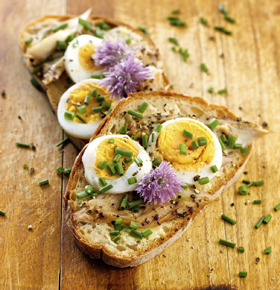
Pâtétaining:
Bring Spring into the Kitchen with Edible Flowers
If you're looking for a presentation that will really wow, turn to your garden! Edible flowers are all the rage these days, both as an ingredient and as a garnish to beautify your plate. Once popular in the Victorian era, and continually popular in Chinese, Middle Eastern, and Indian cuisine, American and European chefs are once again embracing these striking ingredients.
A fresh bloom makes a delightful addition to any plate. They're an easy way add a touch of class to a relatively humble appetizer. A slice of toast with a spread of pâté, for example, looks like a gourmet feast when topped with a few blossoms. A petal or two scattered on top of a plate of toothpick-speared hors d'oeuvres is also a pleasing presentation.
In addition to acting as an unexpected garnish, organic buds can also be used as an ingredient. Just like any other type of plant, their flavors can vary greatly from species to species. A good rule of thumb is, blooms taste like the plants they came from. Arugula flowers, therefore, are grassy and peppery, while mustard blossoms are spicy and slightly bitter. Use both just as you would their namesake plants – arugula flowers can easily be mixed into a salad topped with pâté and a few drops of balsamic, while mustard blossoms work well in vinaigrettes, or even as a colorful addition to pâté and cornichon sandwiches.
Flowers do have a tendency to taste a bit perfume-y. Moderation is key. When used sparingly, floral notes bring a real freshness to a heavier dish. Lavender is a particularly good match with pâté. Try mixing in just a few petals the next time you serve Chicken Liver Mousse, for an unexpected but welcome taste of the outdoors.
The most important thing to remember when using flowers is that not all plants are safe to eat! Make sure you purchase them from a reputable source. Certainly don't pick any from the side of the road or an unfamiliar garden – they could be coated in dangerous pesticides. Even if grown in a completely organic garden, they still may be toxic to eat. Stick to flowers that are known to be edible, including begonias, marigolds, carnations, clover, dandelions, gladiolus, chive or garlic blossoms, lavender, hibiscus, lilacs, marigolds, nasturtiums, pansies, peonies, and roses. When chosen and deployed wisely, you'll have a gorgeous presentation that is positively blossoming with flavor.
